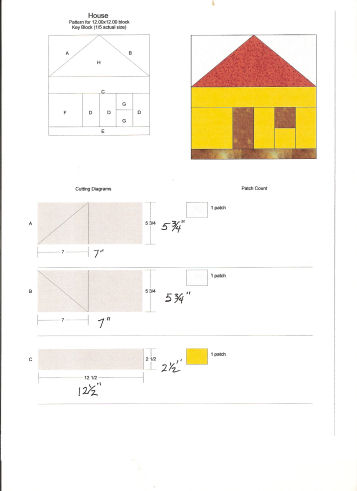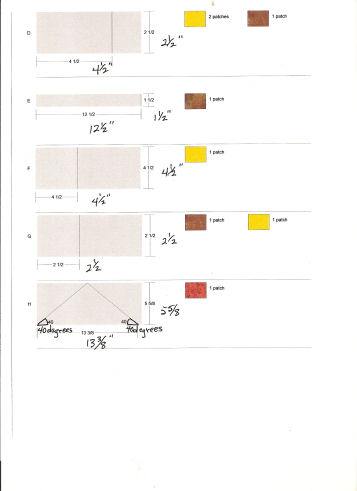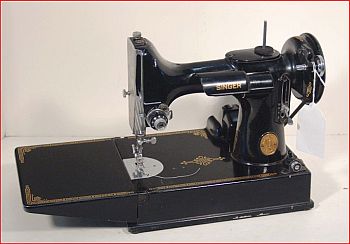Hi there, EveryBuddy.
This Blog is a milestone. Ya know, sometimes when you count things, (anything noteworthy) the numbers that end in Zero are important. That goes especially in Birthdays, like 20, 40, etc. Some of ‘em, are BIG ones. Well, my friends, this Blog is one of those. I propose a guessing game. The first one of you who can tell me how many BLOGS I have written for Ann The Gran will receive three fat Quarters from me in the color of your choice. (Exclusions: Anyone who works in or for Ann The Gran, including Bloggers; my family; and anyone with the hair color of Hot Pink with Green stripes) The prize will be awarded after my first opportunity to visit a quilt shop, and the winner will be announced in my next Blog.
Now, onto the business of the day: Last time I promised that I would begin a series on applique. Also I told “Nancy in IN” that I would talk more about the beautiful little machine, the Singer Model 221, Featherweight. I think all of that is a bit more than one Blog can handle. So I will just add a bit about the Featherweight for this time.
While considering the topic of Applique, I must tell you that applique is a very big subject under the heading of quilting. There are so many techniques and methods in applique that in this forum, I can only talk in brief. So, if you like applique, I would like to recommend that you find a book or two of your own to help you along. This is a list of the books I own:
--Applique Made Easy, by Rodale Books, a really good book that covers a little on all aspects of applique. I recommend it highly to help you choose the type of applique to do.
–Mastering Machine Applique, by Harriet Hargrave, C & T Publishing, a comprehensive study on Machine Applique. The only thing about this book that I disagree with is that I would always use Misty Fuse instead of the other Fusing products that she talks about.
–The New Applique Sampler, by Beck Goldsmith and Linda Jenkins, C & T Publishers. This is a wonderful book on needle-turn applique. I love this book. It has photo illustrations and really good instruction. A video CD can also be purchased separately.
We’ll talk about a simple fused applique design today. I will include the pattern, or you may choose one of your own.
The pattern here is for an 8-inch block. It is to be fused on an 8-1/2 inch background. I used a piece of unbleached muslin.

The first photo shows a piece of Misty Fuse web. It will be place between parchment paper and the applique fabric, making a fusible piece of fabric.

The second photo shows the items I used to make my fused applique block. I have shown a Misty Fuse package in the photo. It has very good instructions that will help you to use it correctly.
You can buy Misty Fuse on Annthegran here
Esterita Austin has a good video cd that explains fusing on her site: www.esteritaaustin.com


Use my pattern or use your own.
To download the sunbonnet sue click here.
Using a piece of parchment paper, trace the pattern pieces each separately, and number them in the order they will be placed on the background fabric.
Cut out pattern pieces, leaving a small paper border around each piece as shown in the second photo.
Heat your iron. Misty Fuse is the only fusible I have used that is NOT very specific about ironing temperature. The right temp. for the fabric used will be the right temp. to use for your project. Also, the timing is not critical for Misty Fuse as in other brands of fusible. That’s one thing that makes it great. I have used other brands that come loose if they are heated too long and will not hold. With Misty Fuse, I usually count to about five or six, and it’s done. However, a longer time does not seem to affect the quality of the fusible hold.
You will need two large pieces of parchment paper to sandwich your fusible pieces. Place a piece of parchment paper on your ironing surface, large enough to fit your project. Place a piece of fabric slightly larger than your pattern piece, face down, on the parchment paper. Next, place Misty Fuse, about the size of the pattern piece. Then place the pattern piece, face up, on the Misty Fuse. Place another large piece of parchment on top.
Check it-- 1. Face down fabric, 2. Misty Fuse, 3. Face-up pattern piece, sandwiched between two pieces of parchment paper. This photo shows me holding the Misty Fuse and pattern piece, ready to apply it to fabric.

Now you will cut out the fused pattern/fabric pieces, on the traced lines. Place the pattern pieces on the background fabric in the numbered order, between the sheets of parchment paper. Check placement. You can press all the pieces at one time. However, if you want to be more careful, you can press them one at a time. I used my traced pattern under the background fabric as a guide for fabric placement, as shown in this photo. When you have fused all the pieces to the fabric, you are done for now. This photo shows how I used my pattern for placement.

Next time, I will tell you how to do the machine stitching to finish the fused applique block.
Please don’t think that what I say here is all you need to know. This is only a beginning. You really need to go farther and take a class, buy a book and practice, practice, practice.
More on epplique next time.
The next two photos are my favorite quilt. It is hanging in my sewing room. Unfortunately, I made this quilt a short time before I found Misty Fuse. I love the resulting quilt, except that all the appliques are very stiff. I am afraid to fold this quilt across the appliques because I don’t want it to have any permanent folds that might result from folding on that kind of fusible. That is the reason I LOVE Misty Fuse. It is not stiff between layers of fabric.
The first quilt I made with Misty Fuse was the quilt I made for my Grand daughter Savannah. It is shown in one of my very early Blogs. It is a little girl’s quilt, so it needed to be well loved and easy to wash. Misty Fuse has performed perfectly, making a soft and lovable quilt that Savannah has loved for almost four years.


Now, Friends, it is on to our Block of the Month. This time, we will be making a pieced House block. The pattern is
given here (Click here to download the full size images)


To download the above pattern images click here.
It makes a finished 12 inch block. Remember, that it will measure 12 ½ inches square, before assembly in the quilt.

These are the blocks that I have finished so far. Let me know how you are doing with all of your blocks. I’d like you all to get me up to date on how you are doing with your project.

Singer Featherweight, Model 221
This is a Singer Featherweight. They are wonderful machines that are no longer made, unfortunately.
I will do more study to tell you more history next time. For right now, I’ll just tell you what I know. I’ve had my machine for over ten years. I purchased mine from a friend in quilt guild. The original owner was a former quilt guild member. So I am the third owner of this machine. Actually, I own two, one is in great condition, the other one, a little less.
Featherweights are a favorite of quilters because they are light weight, only twelve pound, most come with a carrying care. They are wonderful machines because for the most part, they can be self serviced. They are very simple, electric machines. I also own a book that was written expressly for Featherweight owners who want to repair themachines themselves. In fact, my husband and I just did repairs on a friend’s machine last week. It was great. If you are interested in one, go web shopping, and learn more about them before you take a step out of the house. Type "Singer Featherweight", into your browser and sit back for a few hours and learn all you can. There is a lot to learn.
However, if you think you want one, please USE It. I really don’t like the idea of these little beauties sitting on the shelf of a NON-sewer. Yes, they are considered antiques, and valuable at that. But they are also perfect for simple sewing and especially piecing of quilts. These machine are very much like the very first little singer machine that I was given as a HS graduation gift. That machine was not a Feather weight, but it was a small Singer straight stitch machine. Wish I hadn’t sold it. If this is your ifrst visit with LaRueSews-Quilts, check my earlierBlogs. You will find links in the box above on this page. Glad to have you with us. Join our block of the Month.
See y’all next time
Stitches to you,
LaRue